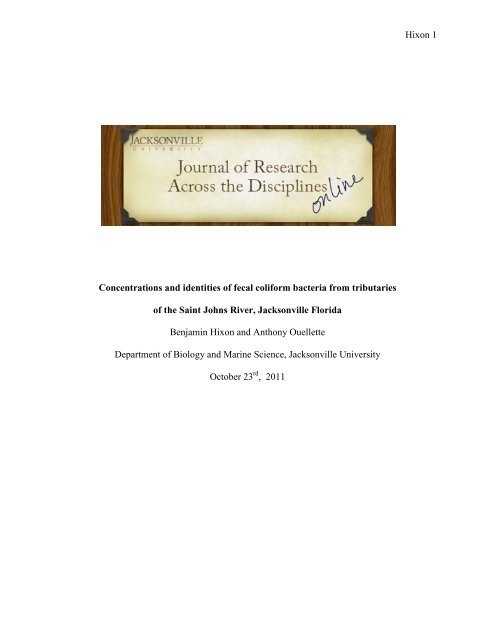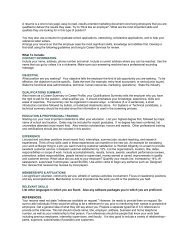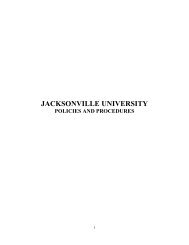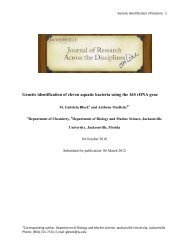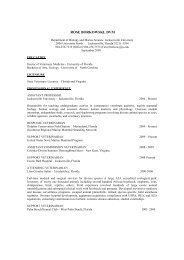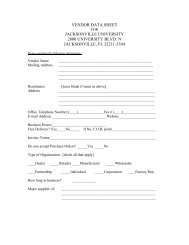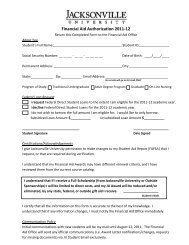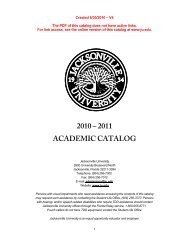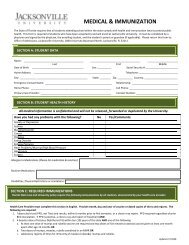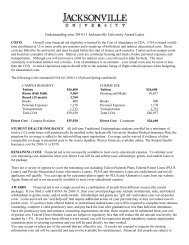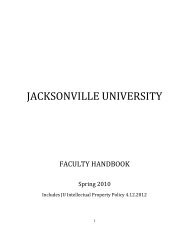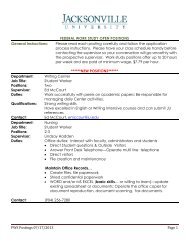Hixon 1 Concentrations and identities of fecal coliform bacteria from ...
Hixon 1 Concentrations and identities of fecal coliform bacteria from ...
Hixon 1 Concentrations and identities of fecal coliform bacteria from ...
You also want an ePaper? Increase the reach of your titles
YUMPU automatically turns print PDFs into web optimized ePapers that Google loves.
<strong>Hixon</strong> 1<br />
<strong>Concentrations</strong> <strong>and</strong> <strong>identities</strong> <strong>of</strong> <strong>fecal</strong> <strong>coliform</strong> <strong>bacteria</strong> <strong>from</strong> tributaries<br />
<strong>of</strong> the Saint Johns River, Jacksonville Florida<br />
Benjamin <strong>Hixon</strong> <strong>and</strong> Anthony Ouellette<br />
Department <strong>of</strong> Biology <strong>and</strong> Marine Science, Jacksonville University<br />
October 23 rd , 2011
<strong>Hixon</strong> 2<br />
ABSTRACT<br />
Over the centuries humans have impacted many streams <strong>and</strong> rivers in Florida causing<br />
many <strong>of</strong> them to become polluted. Fecal <strong>coliform</strong> <strong>bacteria</strong>, which live in the guts <strong>of</strong> warm<br />
blooded animals, are common in polluted streams <strong>and</strong> rivers <strong>and</strong> are currently used as indicators<br />
<strong>of</strong> the presence <strong>of</strong> human pathogenic microorganisms. There are over 100 tributarites that flow<br />
into the Saint Johns River in Jacksonville Florida that are monitored for <strong>fecal</strong> <strong>coliform</strong> <strong>bacteria</strong>.<br />
According to the Florida Department <strong>of</strong> Environmental Protection (FDEP) if there are more than<br />
800 <strong>fecal</strong> <strong>coliform</strong> colony forming units (CFUs) per 100mL, the water is deemed not safe for<br />
human recreation. This paper focuses on descriptive <strong>and</strong> comparative research at six sites along<br />
the Saint Johns River near Jacksonville University (JU). The <strong>fecal</strong> <strong>coliform</strong> <strong>bacteria</strong> ranged <strong>from</strong><br />
1 to 1067 CFUs/100mL, with the highest counts at Jacksonville University. There were no<br />
apparent relationships seen between <strong>fecal</strong> <strong>coliform</strong> <strong>bacteria</strong> CFUs <strong>and</strong> water temperature,<br />
dissolved oxygen, salinity, <strong>and</strong> pH. Common <strong>fecal</strong> <strong>coliform</strong> <strong>bacteria</strong> belonging to the genera<br />
Escherichia, Klebsiella, <strong>and</strong> Citrobacter were identified.<br />
INTRODUCTION<br />
Water quality is a serious issue that affects many U.S. streams <strong>and</strong> rivers, including the<br />
Saint Johns River in Jacksonville Florida. According to a report by Lui et al. (2010) that assessed<br />
39% <strong>of</strong> the United States streams <strong>and</strong> rivers, 19% were found to be impaired, <strong>of</strong> which 35%<br />
percent were polluted by <strong>fecal</strong> <strong>coliform</strong> <strong>bacteria</strong>. Fecal <strong>coliform</strong> <strong>bacteria</strong> are listed as the leading<br />
causes <strong>of</strong> water quality impairment in rivers <strong>and</strong> streams <strong>and</strong> the second leading cause in<br />
estuaries (Liu et al. 2010).
<strong>Hixon</strong> 3<br />
Fecal <strong>coliform</strong> <strong>bacteria</strong> are part <strong>of</strong> the gut flora <strong>of</strong> warm blooded animals <strong>and</strong> are<br />
commonly used as indicators <strong>of</strong> the presence <strong>of</strong> <strong>fecal</strong> material <strong>and</strong> sewage contamination<br />
(Toothman et. al. 2009). Water that contains contaminants <strong>from</strong> <strong>fecal</strong> material <strong>from</strong> warm<br />
blooded animals is likely to have human pathogenic microorganisms (Messyasz et al. 2010).<br />
Fecal <strong>coliform</strong> pathogens can become problematic if the water is unfiltered <strong>and</strong> used for<br />
recreational activities, shellfish harvesting, irrigation, <strong>and</strong> drinking water production (Servais et<br />
al. 2009).<br />
It has been proposed that <strong>fecal</strong> <strong>bacteria</strong> concentrations are enhanced by increased<br />
phosphorus concentrations. Burkholder et al. (2007) <strong>and</strong> Mallin et al. (2009) suggested that there<br />
is a positive correlation between <strong>fecal</strong> <strong>bacteria</strong> <strong>and</strong> nutrient concentrations due to either a<br />
common source or a r<strong>and</strong>om arrival <strong>of</strong> nutrients <strong>and</strong> <strong>fecal</strong> <strong>bacteria</strong> in one region. However,<br />
Sheheta et al. (1971) found that in areas with low nutrient concentrations <strong>fecal</strong> <strong>coliform</strong> <strong>bacteria</strong>,<br />
specifically E. coli, were dependent on phosphorus concentrations. Researchers <strong>from</strong> the<br />
University <strong>of</strong> North Carolina Wilmington continuously monitored water <strong>from</strong> the Bradley Creek<br />
watershed for 11 years; during a time <strong>of</strong> continuously high <strong>fecal</strong> <strong>coliform</strong> concentrations, urban<br />
storm water run<strong>of</strong>f was identified as the major contributor <strong>of</strong> <strong>fecal</strong> <strong>coliform</strong> <strong>bacteria</strong> to the<br />
watershed (Toothman et. al. 2009).<br />
Fecal <strong>coliform</strong> <strong>bacteria</strong> that are antibiotic resistant have also been isolated <strong>from</strong> river<br />
water near wastewater treatment plants. Microbial source tracking is typically used to track<br />
antibiotic resistance patterns <strong>of</strong> <strong>fecal</strong> <strong>bacteria</strong> to find the origin <strong>of</strong> the <strong>fecal</strong> pollution within<br />
specific aquatic environments. Servais et al. (2009) investigated antibiotic resistance <strong>of</strong> the <strong>fecal</strong><br />
<strong>coliform</strong> <strong>bacteria</strong> Escherichia coli <strong>and</strong> intestinal enterococci isolated <strong>from</strong> the Seine River<br />
watershed using the disk diffusion method. It was found that 43% <strong>of</strong> the sampled E. coli <strong>and</strong>
<strong>Hixon</strong> 4<br />
83% <strong>of</strong> the intestinal enterococci were resistant to at least one antimicrobial agent (Servais et al.<br />
2009). In fact, most E. coli are resistant to multiple antimicrobial agents due to the pumps in their<br />
outer membrane (Musgrove et al. 2006).<br />
Fecal <strong>coliform</strong> <strong>bacteria</strong> are found in the Saint Johns River <strong>and</strong> its surrounding tributaries<br />
because <strong>of</strong> failing septic tanks, wastewater treatment plants, broken sewer lines, <strong>and</strong> animal<br />
waste (St. Johns River Keeper 2011). The Saint Johns River is a diverse ecosystem with slowly<br />
moving water that historically has had a lot <strong>of</strong> pollution problems; however, since the mid 1970’s<br />
<strong>and</strong> the creation <strong>of</strong> the clean water act <strong>of</strong> 1972, community efforts <strong>and</strong> initiatives addressing the<br />
<strong>bacteria</strong>l sources have improved the overall quality <strong>of</strong> the river (Hollingsworth 2007). The major<br />
sources <strong>of</strong> pollutants, such as <strong>fecal</strong> <strong>coliform</strong> <strong>bacteria</strong>, are discharges <strong>from</strong> wastewater treatment<br />
plants <strong>and</strong> water run<strong>of</strong>f caused by rain (SJRWMD 2011). The root <strong>of</strong> the problem comes <strong>from</strong><br />
nutrients <strong>and</strong> chemical contaminants that enter the river as either point-source or non-point<br />
source discharges. Point source discharges include domestic <strong>and</strong> industrial wastewater treatment<br />
plants, <strong>and</strong> usually enter the river through a man-made pipe or channel. The Saint Johns River is<br />
also affected by non-point source discharges which include septic tank leaching, ground water<br />
intrusion, run<strong>of</strong>f <strong>from</strong> roads <strong>and</strong> highways, pasture l<strong>and</strong>s <strong>and</strong> forestry, <strong>and</strong> storm water collection<br />
systems which have no fixed entry point, making it difficult to find the main source <strong>of</strong> the<br />
pollution (Maher 2007). Algal blooms, which have detrimental effects on aquatic ecosystems,<br />
have the ability to form in the Saint Johns River due to the rivers warm water temperature <strong>and</strong><br />
high level <strong>of</strong> excess nutrients, such as phosphorus <strong>and</strong> nitrogen, <strong>from</strong> both point source <strong>and</strong> nonpoint<br />
source discharges (Cadenhead 2007).<br />
The city <strong>of</strong> Jacksonville Florida (COJ) monitors over one-hundred tributaries belonging<br />
to the Saint Johns River on a quarterly basis. The tributaries are measured for dissolved oxygen
<strong>Hixon</strong> 5<br />
levels, <strong>fecal</strong> <strong>coliform</strong> <strong>bacteria</strong> concentrations, <strong>and</strong> other st<strong>and</strong>ards <strong>of</strong> water quality. According to<br />
Florida State st<strong>and</strong>ards, if a body <strong>of</strong> water contains 800 or more <strong>fecal</strong> <strong>coliform</strong> colony forming<br />
units (CFUs) per 100mL, then the water is deemed not safe for human recreational activities like<br />
fishing, <strong>and</strong> swimming (Tributary program 2011).<br />
This paper describes descriptive <strong>and</strong> comparative research on total <strong>bacteria</strong> <strong>and</strong> <strong>fecal</strong><br />
<strong>coliform</strong> <strong>bacteria</strong> concentrations in tributaries that flow into the St. Johns River at or within a<br />
close vicinity <strong>of</strong> Jacksonville University. Fecal <strong>coliform</strong> <strong>bacteria</strong> CFUs were measured at four<br />
sites currently being measured by the city <strong>of</strong> Jacksonville (COJ) <strong>and</strong> at two other sites on the<br />
Jacksonville University Campus that were not previously monitored. Dissolved oxygen, pH,<br />
salinity, <strong>and</strong> water temperature were measured at all sites during both sample collections. The<br />
resulting data was compared to <strong>fecal</strong> <strong>coliform</strong> CFUs for both collections at all the sample sites in<br />
search <strong>of</strong> potential relationships.<br />
METHODS<br />
Six sampling locations at Jacksonville University in Jacksonville, FL or within a few<br />
miles <strong>of</strong> the university were monitored (figure1). All water samples were collected <strong>from</strong> either<br />
the Saint Johns River or surrounding tributaries. Four <strong>of</strong> the six samples (LB1, DR1, ALR7,<br />
ARL3) were tributary sites already being monitored quarterly by the city <strong>of</strong> Jacksonville <strong>and</strong> two<br />
(JU1, JU2) were not previously monitored <strong>and</strong> on the Jacksonville University campus. The order<br />
for both sampling collections was consistent <strong>and</strong> in the order: LB1, DR1, JU2, JU1, ARL7,<br />
ARL3. JU2 is the only sample site that is in the St. Johns River. For the sites that were<br />
previously monitored, data <strong>and</strong> results are available <strong>from</strong> the city <strong>of</strong> Jacksonville’s tributary<br />
monitoring website for February to March 2009 (Tributary program 2011).
<strong>Hixon</strong> 6<br />
NAME<br />
OF<br />
SAMPLE<br />
AREA<br />
LB1<br />
DR1<br />
JU2<br />
JU1<br />
ARL7<br />
ARL3<br />
LOCATION<br />
Long Branch at Wigmore Street<br />
Deer Creek at Talleyr<strong>and</strong> Avenue<br />
JU boathouse dock<br />
Creek/pipe run<strong>of</strong>f at JU dock inlet<br />
Unnamed Stream at Ferber Road<br />
Red Bay Branch at Lone Star Road<br />
Figure 1: Locations <strong>of</strong> Sample sites. COJ does not monitor JU1 <strong>and</strong> JU2.<br />
http://www.coj.net/NR/rdonlyres/ejld2jez3myhqoq37l2wi4c2rsf2paanfw5s4tqsa4zyg4ws2wkrhy<br />
q6w5bmj27lvb7aihpyupfxmve6kd3om3yslkc/Fecal+map+1st+quarter+2004.pdf<br />
At each sample site, an 800mL water sample was collected in a sterile plastic container<br />
just prior to low tide. Water temperature, salinity, <strong>and</strong> dissolved oxygen were measured in a<br />
small separate sample collected in a 50mL beaker using Exstik DO600 Dissolved Oxygen meter<br />
<strong>and</strong> Exstik pH/ Conductivity/ TDS/ Salinity/ Temperature meter. All samples were taken back to<br />
the Jacksonville University microbiology lab for testing no later than 4 hours after collection.
<strong>Hixon</strong> 7<br />
Testing began with using the membrane filtration technique: triplicates <strong>of</strong> 50mL <strong>of</strong> each sample<br />
was filtered on 0.45µm filters <strong>and</strong> then placed onto M-FC agar (Fisher Scientific Catalog<br />
Number DF0677173), which is selectable for <strong>fecal</strong> <strong>coliform</strong> <strong>bacteria</strong>l growth, in 50x9mm Petri<br />
dishes. The incubation period for the 1/29/11 collection was 24 hours <strong>and</strong> 37 minutes <strong>and</strong> 18<br />
hours <strong>and</strong> 35 minutes for 3/12/11 collection at 46 ºC. Fecal <strong>coliform</strong> CFUs were visually counted<br />
using a Leica Quebec Darkfield Colony Counter <strong>and</strong> these numbers were multiplied by two to<br />
calculate <strong>fecal</strong> <strong>coliform</strong> CFUs per 100mL (table 1). Only blue colonies were counted, all brown<br />
or <strong>of</strong>f white colonies were considered not to be <strong>fecal</strong> <strong>coliform</strong> <strong>bacteria</strong> CFUs. Water pH was<br />
measured using a Corning pH meter 125, which was calibrated prior to use. To calculate total<br />
<strong>bacteria</strong>l counts, triplicates <strong>of</strong> serial dilutions using 0.85% NaCl in 100mL dilution containers<br />
were completed in tenfold increments <strong>from</strong> tenfold to one-thous<strong>and</strong> fold, followed by plating a<br />
0.1mL sample onto TSA <strong>and</strong> incubating for 42 hours <strong>and</strong> 5 minutes at 37 ºC prior to counting.<br />
IDENTIFICATION OF FECAL COLIFORM BACTERIA<br />
Morphological, physiological, <strong>and</strong> metabolic tests were used to identify <strong>and</strong> differentiate<br />
<strong>fecal</strong> <strong>coliform</strong> <strong>bacteria</strong> <strong>from</strong> each <strong>of</strong> the sampling locations. Three r<strong>and</strong>om <strong>and</strong> separate <strong>fecal</strong><br />
<strong>coliform</strong> <strong>bacteria</strong> colonies, one <strong>from</strong> each <strong>of</strong> the three triplicate plates per sample site (totaling 18<br />
isolates), were chosen <strong>and</strong> successively quadrant streaked six times on m-endo agar (Fisher<br />
Scientific Catalog Number DF0677173), in order to promote only <strong>fecal</strong> <strong>coliform</strong> <strong>bacteria</strong> growth.<br />
Single colonies were used for testing <strong>and</strong> each sample was quadrant streaked on a new m-endo<br />
plate weekly in order to have living <strong>bacteria</strong> available for all tests. Before individual <strong>fecal</strong><br />
<strong>coliform</strong> <strong>bacteria</strong> testing for differentiation among <strong>fecal</strong> <strong>coliform</strong> <strong>bacteria</strong> began, m-endo slants<br />
were streaked, incubated for 11 hours <strong>and</strong> 20 minutes, sealed tight, <strong>and</strong> store in a refrigerator<br />
with a temperature ranging <strong>from</strong> 0 to 5ºC for preservation. The methods for identification were
<strong>Hixon</strong> 8<br />
completed using the techniques described by Lammert et al. (2007), unless otherwise noted. All<br />
tests for differentiation were decided upon after researching various test result differences among<br />
the different <strong>fecal</strong> <strong>coliform</strong> <strong>bacteria</strong> genera Citrobacter, Enterobacter, Escherichia, <strong>and</strong><br />
Klebsiella in Bergey’s Manual <strong>of</strong> Determinative Bacteriology. In order to confirm isolation <strong>of</strong> a<br />
single bacterium, gram stains were prepared with both a gram positive control Bacillus<br />
megaterium <strong>and</strong> a gram negative control Psuedomonas aeruginosa for comparison. Gram stains<br />
were also used to measure the length <strong>and</strong> width <strong>of</strong> individual <strong>bacteria</strong>l cells <strong>and</strong> to note cell<br />
morphology using Motic Imaging S<strong>of</strong>tware <strong>and</strong> Swift Cam 5. Bacteria cell measurements were<br />
completed by measuring the lengths <strong>and</strong> widths <strong>of</strong> ten separate <strong>bacteria</strong>l cells followed by<br />
calculating the average <strong>and</strong> the st<strong>and</strong>ard deviation. In order to confirm <strong>bacteria</strong>l cell size <strong>and</strong><br />
morphology a negative stain was completed. To test if the <strong>bacteria</strong> were able to produce capsules<br />
(Capsule stain) the <strong>bacteria</strong> were first grown on sucrose gelatin agar, whereas all other tests used<br />
<strong>bacteria</strong> samples grown on m-endo agar. The <strong>bacteria</strong> were tested for their ability to utilize<br />
citrate as a carbon source (Citrate test), to ferment acid by mixed acid fermentation (Methyl-red<br />
test), to conduct butanediol fermentation (Voges-proskauer test), <strong>and</strong> the ability to grow on<br />
media that inhibits the growth <strong>of</strong> Gram-positive <strong>bacteria</strong> <strong>and</strong> provides a color indicator<br />
distinguishing between organisms that ferment lactose <strong>and</strong> those that do not (EMB agar). The<br />
<strong>bacteria</strong> were also tested for motility <strong>and</strong> indole production (SIM test).<br />
RESULTS AND DISCUSSION<br />
FECAL COLIFORM CFU’s
<strong>Hixon</strong> 9<br />
All samples were collected around low tide in the Saint Johns River. The first collection<br />
<strong>of</strong> water samples were completed on January 29 th 2011 <strong>from</strong> 11:48 to 15:20 <strong>and</strong> the second<br />
collection <strong>of</strong> water samples were completed on March 12 th 2011 <strong>from</strong> 6:30 to 8:30. Low tide for<br />
the 1/29/11 collection was at 12:59 <strong>and</strong> 9:15 for the 3/12/11 collection. The outside air<br />
temperature for the 1/29/11 collection was 17.8ºC <strong>and</strong> 6.7ºC for the 3/12/11 collection. The<br />
average <strong>fecal</strong> <strong>coliform</strong> <strong>bacteria</strong> concentrations for the 1/29/11 collection ranged <strong>from</strong> 34 to 1067<br />
CFUs/100mL, with JU1 being the highest. For the 3/12/11 collection, the average <strong>fecal</strong> <strong>coliform</strong><br />
<strong>bacteria</strong> concentrations was much less than 1/29/11 <strong>and</strong> ranged <strong>from</strong> 1 to 124 CFUs/100mL, with<br />
LB1 being the highest <strong>and</strong> JU1 being the second highest (99 CFUs/100mL). Site JU1 enters the<br />
Saint Johns River <strong>from</strong> a pipe that goes under the road leading to the Jacksonville University’s<br />
boat house. Based on numerous visual observations, the water coming out <strong>of</strong> this pipe is assumed<br />
to be constantly flowing. After tracking the stream it was found that it is short, going through the<br />
woods <strong>and</strong> eventually drying up upstream before approaching a road on main campus. It is<br />
believed the water in this stream is primarily <strong>from</strong> run<strong>of</strong>f <strong>from</strong> the densely wooded area the<br />
stream travels through. The root cause <strong>of</strong> the high <strong>fecal</strong> <strong>coliform</strong> CFUs has not been proven; but<br />
it is assumed that it is due to <strong>fecal</strong> material <strong>from</strong> animals running <strong>of</strong>f into the stream. JU2 had the<br />
lowest <strong>fecal</strong> <strong>coliform</strong> CFUs at both collections, which was due to the site being the only sampled<br />
location that was in the St. Johns River <strong>and</strong> not a tributary; it is expected that the <strong>fecal</strong> <strong>coliform</strong><br />
<strong>bacteria</strong> concentration is diluted in the river. Fecal <strong>coliform</strong> <strong>bacteria</strong> concentrations for the<br />
1/29/11 collection were more consistent with the City <strong>of</strong> Jacksonville (COJ) data than the<br />
3/12/11 collection. Comparing 1/29/11 <strong>and</strong> 3/12/11 <strong>fecal</strong> <strong>coliform</strong> <strong>bacteria</strong> CFUs data with COJ<br />
data <strong>from</strong> February 2009, the differences for the 1/29/11 collection ranged <strong>from</strong> 20 to 460 CFUs,<br />
with LB1 having the largest difference, <strong>and</strong> differences for the 3/12/11 collection ranged <strong>from</strong>
Location<br />
Date <strong>of</strong> Sample<br />
Data Source<br />
Water Temp (°C)<br />
pH<br />
Salinity (ppT)<br />
Dissolved Oxygen (mg/L)<br />
Fecal <strong>coliform</strong> CFUs per 100mL<br />
Bacteria CFUs per 100mL<br />
<strong>Hixon</strong> 10<br />
124 to 397 CFUs, with DR1 having the largest difference (table 1). The closest similarity among<br />
COJ data values <strong>and</strong> those <strong>of</strong> the 1/29/11 <strong>and</strong> 3/12/11 collections were seen at the ARL3 sample<br />
site, indicating there were no major flaws in experimental procedures giving reassurance that all<br />
collected data was accurate. For both sample collections, the highest <strong>fecal</strong> <strong>coliform</strong> <strong>bacteria</strong><br />
concentrations were found at JU1 <strong>and</strong> LB1 with the exception <strong>of</strong> sample site ARL7 (table 1). All<br />
sample locations had lower <strong>fecal</strong> <strong>coliform</strong> CFUs at the 3/12/11 collection compared to COJ <strong>fecal</strong><br />
<strong>coliform</strong> CFU data <strong>from</strong> February 2009 <strong>and</strong> data <strong>from</strong> the 1/29/11 collection (figure 2). Lower<br />
<strong>fecal</strong> <strong>coliform</strong> CFUs at all sites for the 3/12/11 collection could be due to all the water samples<br />
being collected before low tide causing them to be diluted while some <strong>of</strong> the 1/29/11 samples<br />
were collected past low tide, the colder air <strong>and</strong> cold water temperatures for all samples could <strong>of</strong><br />
potentially not allowed the <strong>fecal</strong> <strong>coliform</strong> <strong>bacteria</strong> to replicate as efficiently (table 1), a<br />
difference in tidal heights potentially causing the samples be diluted, a shorter incubation period<br />
not allowing all the <strong>fecal</strong> <strong>coliform</strong> colonies to grow, or for some other reason not mentioned<br />
here. In order to accurately determine the cause or causes <strong>of</strong> this difference more research would<br />
need to be completed. All data for all sample collections <strong>and</strong> COJ data can be seen found in<br />
table 1.
<strong>Hixon</strong> 11<br />
573,300<br />
LB1 1/29/2011 TS 18.0 6.81 0.80 6.32<br />
941 ±<br />
81<br />
±<br />
197,300<br />
LB1 3/12/2011 TS 12.4 5.80 4.85 3.24<br />
124 ±<br />
143 -<br />
LB1 2/3/2009 COJ 13.9 - 0.65 6.54 480 -<br />
282 ±<br />
1,873,300<br />
±<br />
DR1 1/29/2011 TS 18.6 6.74 0.79 6.79 53 315,300<br />
DR1 3/12/2011 TS 11.6 6.30 0.97 2.26 43 ± 29 -<br />
DR1 2/3/2009 COJ 13.9 - 0.54 2.52 440 -<br />
140,000<br />
± 10,000<br />
JU2 1/29/2011 TS 15.9 7.60 7.84 9.05 34 ± 12<br />
10.0<br />
JU2 3/12/2011 TS 14.5 6.32 + 4.59 1 ± 2 -<br />
2,596,700<br />
±<br />
158,200<br />
JU1 1/29/2011 TS 17.8 6.67 0.21 7.29<br />
1,067 ±<br />
53<br />
JU1 3/12/2011 TS 12.1 6.34 0.22 3.83 99 ± 81 -<br />
ARL7 1/29/2011 TS 25.0 7.07 3.42 7.40<br />
724 ±<br />
71<br />
1,086,700<br />
± 75,700<br />
ARL7 3/12/2011 TS 12.9 6.19 4.81 3.63 4 ± 4 -<br />
ARL7 2/9/2011 COJ 17.2 - 0.15 8.12 380 -<br />
ARL3 1/29/2011 TS 19.1 6.76 0.28 6.58<br />
140 ±<br />
10<br />
195,000<br />
± 35,400<br />
ARL3 3/12/2011 TS 17.8 6.41 0.33 1.82 36 ± 47 -<br />
ARL3 2/9/2011 COJ 17.2 - 0.22 7.01 160 -<br />
KEY<br />
TS = Data <strong>from</strong> this study<br />
COJ= Data <strong>from</strong> the City <strong>of</strong> Jacksonville Tributary Monitoring Program<br />
- = Data is unknown or unavailable<br />
Table 1: Measured <strong>and</strong> COJ Fecal <strong>coliform</strong> CFUs, water temperature, Salinity, Dissolved<br />
oxygen, <strong>and</strong> <strong>bacteria</strong>l CFUs for all water samples. COJ does not monitor JU1 <strong>and</strong> JU2 so no<br />
previous values are available.
<strong>Hixon</strong> 12<br />
Figure 2: Comparison <strong>of</strong> <strong>fecal</strong> <strong>coliform</strong> CFUs data <strong>from</strong> this study to COJ data. Comparing first<br />
collection <strong>fecal</strong> <strong>coliform</strong> CFUs per 100mL to second collection <strong>fecal</strong> <strong>coliform</strong> CFUs <strong>and</strong> City <strong>of</strong><br />
Jacksonville Tributary Monitoring Program <strong>fecal</strong> <strong>coliform</strong> CFUs data <strong>from</strong> 2/2009 collection.<br />
According to the FDEP extreme levels <strong>of</strong> <strong>fecal</strong> <strong>coliform</strong> <strong>bacteria</strong> is 800+ displayed in red,<br />
moderate levels is 200 to 799 displayed in yellow, <strong>and</strong> low levels is 0 to 199 displayed in green.<br />
CHEMICAL AND PHYSICAL COMPONENTS<br />
Fecal <strong>coliform</strong> <strong>bacteria</strong> CFUs/100mL for each sample site were compared with the<br />
dissolved oxygen (DO), salinity, water temperature, <strong>and</strong> pH measurements to determine whether<br />
or not these measurements affect <strong>fecal</strong> <strong>coliform</strong> <strong>bacteria</strong> concentrations. Sample data <strong>from</strong><br />
collection one (1/29/11) <strong>and</strong> collection two (3/12/11) were used for analysis along with COJ data<br />
<strong>and</strong> trends for comparison. After analysis <strong>of</strong> the data, no correlations between these factors <strong>and</strong><br />
the <strong>fecal</strong> <strong>coliform</strong> <strong>bacteria</strong> CFUs per 100mL were found, as indicated by the low R 2 values for all<br />
<strong>of</strong> the graphs (figure 3). More sampling <strong>from</strong> each site would need to be completed in order to<br />
accurately determine if changes <strong>of</strong> pH, DO, salinity, or water temperature affect <strong>fecal</strong> <strong>coliform</strong>
<strong>Hixon</strong> 13<br />
<strong>bacteria</strong> concentrations. Also, each site would need to be analyzed separately because different<br />
sites naturally have different concentrations <strong>of</strong> <strong>fecal</strong> <strong>coliform</strong> <strong>bacteria</strong> to begin with, thus not<br />
allowing for an accurate comparison.<br />
Figure 3: Comparison <strong>of</strong> physical <strong>and</strong> chemical components <strong>and</strong> <strong>fecal</strong> <strong>coliform</strong> <strong>bacteria</strong> CFUs<br />
<strong>from</strong> data collected in this study on 1/29/11 <strong>and</strong> 3/12/11. A: Comparison <strong>of</strong> <strong>fecal</strong> <strong>coliform</strong> CFUs<br />
<strong>and</strong> water temperature. B: Comparison <strong>of</strong> <strong>fecal</strong> <strong>coliform</strong> CFUs <strong>and</strong> pH. C: Comparison <strong>of</strong> <strong>fecal</strong><br />
<strong>coliform</strong> CFUs <strong>and</strong> salinity. D: Comparison <strong>of</strong> <strong>fecal</strong> <strong>coliform</strong> CFUs <strong>and</strong> dissolved oxygen levels.<br />
E: Comparison <strong>of</strong> <strong>fecal</strong> <strong>coliform</strong> CFUs <strong>and</strong> total <strong>bacteria</strong>l CFUs.<br />
TOTAL BACTERIAL COUNTS<br />
When comparing <strong>fecal</strong> <strong>coliform</strong> <strong>bacteria</strong> CFUs per 100mL with the total <strong>bacteria</strong>l CFUs per<br />
100mL there is no indication that samples with high concentrations <strong>of</strong> <strong>fecal</strong> <strong>coliform</strong> <strong>bacteria</strong><br />
also had high concentrations <strong>of</strong> total <strong>bacteria</strong> (figure 3E). Fecal <strong>coliform</strong> CFUs are typically used
<strong>Hixon</strong> 14<br />
as indicators <strong>of</strong> the potential presence <strong>of</strong> disease causing organisms <strong>and</strong> counted for the purpose<br />
<strong>of</strong> alerting the person responsible for the water to take precautionary action<br />
(Total, Fecal & E. coli Bacteria in Groundwater 2007).<br />
IDENTIFICATION OF FECAL COLIFORM BACTERIA<br />
An attempt was made to identify three different <strong>fecal</strong> <strong>coliform</strong> <strong>bacteria</strong> <strong>from</strong> each sample<br />
site. Bergey’s Manual <strong>of</strong> Determinative Bacteriology was used to decide which tests to use to<br />
differentiate each genus <strong>of</strong> <strong>fecal</strong> <strong>coliform</strong> <strong>bacteria</strong>, <strong>and</strong> then to help identify individual species.<br />
The genera for sixteen <strong>of</strong> the eighteen <strong>bacteria</strong> were identified. Each <strong>bacteria</strong>’s test results are<br />
compared to the closest <strong>of</strong> the four (Citrobacter, Enterobacter, Escherichia, Klebsiella) <strong>fecal</strong><br />
<strong>coliform</strong> <strong>bacteria</strong> genera (Table 2). A complete list <strong>of</strong> test results is available in the appendix.<br />
Citrobacter Escherichia Klebsiella Enterobacter<br />
Escherichia<br />
or<br />
Klebsiella<br />
LB1 X X X<br />
DR1<br />
X<br />
JU2 X X<br />
JU1<br />
X<br />
ARL7 X X X<br />
ARL3 X X<br />
Table 2: Genera <strong>of</strong> the <strong>bacteria</strong> found at each sample site.
<strong>Hixon</strong> 15<br />
Figure 4: Micrograph <strong>of</strong> Escherichia found in sample LB1.<br />
CONCLUSION<br />
Fecal <strong>coliform</strong> <strong>bacteria</strong> originate in the guts <strong>of</strong> warm blooded animals <strong>and</strong> are found in<br />
various tributaries for multiple reasons including failing septic tanks, wastewater treatment<br />
plants, broken sewer lines, <strong>and</strong> animal waste (St. Johns River Keeper 2011 2010). The highest<br />
<strong>fecal</strong> <strong>coliform</strong> CFUs were found during the 1/29/11 collection <strong>and</strong> at the site JU1 with the<br />
concentration <strong>of</strong> 1,067 CFUs/100mL. When analyzing the <strong>fecal</strong> <strong>coliform</strong> <strong>bacteria</strong> st<strong>and</strong>ards in<br />
regards to the state <strong>of</strong> Florida st<strong>and</strong>ards only samples LB1 <strong>and</strong> JU1<strong>from</strong> the 1/29/11 collection<br />
exceeded the state limit <strong>of</strong> 800 CFUs/100mL. More research needs to be done to distinguish<br />
whether <strong>fecal</strong> <strong>coliform</strong> <strong>bacteria</strong> concentrations are affected by pH, dissolved oxygen, salinity, or<br />
water temperature. Fecal <strong>coliform</strong> <strong>bacteria</strong> were identified that belong to the genera Escherichia,<br />
Klebsiella, <strong>and</strong> Citrobacter at all sites in this study.
<strong>Hixon</strong> 16<br />
APPENDIX<br />
SAMPLE /<br />
GENUS<br />
LB1<br />
BACTERI<br />
A 3<br />
0.95 +/-<br />
0.36 x<br />
0.36 +/-<br />
0.052<br />
JU2<br />
BACTERI<br />
A 3<br />
1.35 +/-<br />
0.29 x<br />
0.41 +/-<br />
0.07<br />
JU1<br />
BACTERI<br />
A 1<br />
0.91 +/-<br />
0.30 x 0.34<br />
+/- 0.052<br />
Coccobacill<br />
JU1<br />
BACTERI<br />
A 2<br />
0.79 +/-<br />
0.11 x 0.36<br />
+/- 0.052<br />
Coccobacill<br />
JU1<br />
BACTERI<br />
A 3<br />
0.84 +/-<br />
0.19 x 0.33<br />
+/- 0.048<br />
Coccobacill<br />
ARL7<br />
BACTERI<br />
A 1<br />
0.77 +/-<br />
0.16 x 0.35<br />
+/- 0.071<br />
Coccobacill<br />
Escherich<br />
ia<br />
6.0-2.0 x<br />
1.5-1.0<br />
SIZE (µm)<br />
MORPHOLO<br />
GY Bacillus Bacillus us<br />
us<br />
us<br />
us<br />
Bacillus<br />
GRAM Negative Negative Negative Negative Negative Negative Negative<br />
CAPSULES + + + + + + +<br />
EMB<br />
GROWTH + + + + + + UNK<br />
EMB COLOR<br />
OBSERVATI<br />
ON 23:30<br />
EMB COLOR<br />
OBSERVATI<br />
Dark<br />
Purple w/<br />
GMS<br />
Dark<br />
Purple w/<br />
Dark<br />
Purple w/<br />
GMS<br />
Dark<br />
Purple w/<br />
Dark Purple<br />
w/ GMS<br />
Dark Purple<br />
w/ GMS<br />
Dark Purple<br />
w/ GMS Purple N/A<br />
Dark Purple Dark Purple Dark Purple<br />
ON 49:30 GMS GMS w/ GMS w/ GMS w/ GMS Purple N/A<br />
MR w/ (T) + + + + + + +<br />
VP w/ (T) - - - - - - -<br />
Indole + + + + + + +<br />
Citrate - - - - - - -<br />
Motility + + + + + + +/-<br />
KEY<br />
+ = positive result<br />
- = negative result<br />
UNK = unknown result<br />
[-] = mostly all species within that genus are negative<br />
[+] = mostly all species within that genus are positive<br />
+/- = some species are positive <strong>and</strong> others are negative within that genus<br />
N/A = not applicable<br />
(T)= Triplicate<br />
GMS= Green Metallic Sheen<br />
Table A1: Isolated <strong>fecal</strong> <strong>coliform</strong> <strong>bacteria</strong> test results <strong>and</strong> comparison to the genus Escherichia<br />
test results.
<strong>Hixon</strong> 17<br />
SAMPLE /<br />
GENUS<br />
DR1<br />
BACTERI<br />
A 1<br />
2.23 +/-<br />
0.82 x 0.60<br />
+/- 0.067<br />
DR1<br />
BACTERI<br />
A 2<br />
2.62 +/-<br />
1.02 x 0.66<br />
+/- 0.07<br />
DR1<br />
BACTERI<br />
A 3<br />
1.68 +/-<br />
0.36 x 0.56<br />
+/- 0.053<br />
JU2<br />
BACTERI<br />
A 1<br />
2.80 +/-<br />
0.68 x 0.60<br />
+/- 0.16<br />
JU2<br />
BACTERI<br />
A 2<br />
1.99 +/-<br />
0.50 x 0.58<br />
+/- 0.063<br />
ARL3<br />
BACTERIA<br />
3<br />
0.74 +/-<br />
0.13 x 0.37<br />
+/- 0.048<br />
Coccobacill<br />
us<br />
Citrobact<br />
er<br />
6.0-2.0 x<br />
SIZE (µm)<br />
1.0<br />
MORPHOLO<br />
rodshaped<br />
GY Bacillus Bacillus Bacillus Bacillus Bacillus<br />
GRAM Negative Negative Negative Negative Negative Negative Negative<br />
CAPSULES - - - - - - -<br />
EMB<br />
GROWTH + + + + + + UNK<br />
EMB COLOR<br />
OBSERVATIO<br />
N 23:30<br />
EMB COLOR<br />
OBSERVATIO<br />
Dark<br />
Purple w/<br />
GMS<br />
Dark<br />
Purple w/<br />
Dark<br />
Purple<br />
Dark<br />
Purple w/<br />
GMS<br />
Dark<br />
Purple w/<br />
Purple<br />
Dark<br />
Purple w/<br />
GMS<br />
Dark<br />
Purple w/<br />
Pink <strong>and</strong><br />
Raised<br />
Dark<br />
Light<br />
Pink <strong>and</strong><br />
N 49:30 GMS Purple GMS Purple GMS Raised N/A<br />
MR w/ (T) + + + + + - +<br />
VP w/ (T) - - - - - + -<br />
Indole + + + + + + +/-<br />
Citrate - - - - - + [+]<br />
Motility - - - + - - [+]<br />
KEY<br />
+ = positive<br />
result<br />
- = negative<br />
result<br />
UNK = unknown result<br />
[-] = mostly all species within that genus are negative<br />
[+] = mostly all species within that genus are positive<br />
+/- = some species are positive <strong>and</strong> others are negative within that genus<br />
N/A = not applicable<br />
(T)= Triplicates<br />
GMS= Green Metallic Sheen<br />
Table A2: Isolated <strong>fecal</strong> <strong>coliform</strong> <strong>bacteria</strong> test results <strong>and</strong> comparison to the genus Citrobacter<br />
test results.<br />
N/A
<strong>Hixon</strong> 18<br />
SAMPLE /<br />
GENUS<br />
SIZE (µm)<br />
LB1<br />
BACTERIA<br />
4<br />
0.71 +/- 0.16<br />
x 0.41 +/-<br />
0.032<br />
ARL7<br />
BACTERIA<br />
2<br />
0.78 +/- 0.16<br />
x 0.36 +/-<br />
0.070<br />
ARL3<br />
BACTERIA<br />
1<br />
0.942 +/-<br />
0.33 x 0.38<br />
+/- 0.092<br />
ARL3<br />
BACTERIA<br />
2 Klebsiella<br />
0.79 +/- 0.17<br />
x 0.30 +/-<br />
0.00<br />
MORPHOLOGY Coccobacillus Coccobacillus Coccobacillus Coccobacillus<br />
6.0-0.6 x<br />
1.0-0.3<br />
rodshaped<br />
GRAM Negative Negative Negative Negative Negative<br />
CAPSULES + + + + +<br />
EMB GROWTH + + + + UNK<br />
EMB COLOR<br />
OBSERVATION<br />
23:30 Pink<br />
EMB COLOR<br />
OBSERVATION<br />
49:30 Pink Pink<br />
Pink, Purple<br />
outside<br />
Pink <strong>and</strong><br />
Raised<br />
Pink <strong>and</strong><br />
Raised<br />
Pink <strong>and</strong><br />
Raised<br />
Pink <strong>and</strong><br />
Raised<br />
MR w/ (T) - - - - +/-<br />
VP w/ (T) + - + + +/-<br />
Indole - - + - [-]<br />
Citrate + + + + [-]<br />
Motility - - - - -<br />
KEY<br />
+ = positive result<br />
- = negative result<br />
UNK = unknown result<br />
[-] = mostly all species within that genus are negative<br />
[+] = mostly all species within that genus are positive<br />
+/- = some species are positive <strong>and</strong> others are negative within that genus<br />
N/A = not applicable<br />
GMS= Green Metallic Sheen<br />
(T)= Triplicates<br />
Table A3: Isolated <strong>fecal</strong> <strong>coliform</strong> <strong>bacteria</strong> test results <strong>and</strong> comparison to the genus Klebsiella<br />
test results.<br />
N/A<br />
N/A
<strong>Hixon</strong> 19<br />
SAMPLE /<br />
GENUS<br />
SIZE (µm)<br />
LB1<br />
BACTERIA<br />
2<br />
1.062 +/-<br />
0.14 x 0.37<br />
+/- 0.048<br />
ARL7<br />
BACTERIA<br />
3 Escherichia Klebsiella<br />
0.87 +/- 0.22<br />
x 0.35 +/-<br />
0.053<br />
6.0-2.0 x<br />
1.5-1.0<br />
6.0-0.6 x<br />
1.0-0.3<br />
rodshaped<br />
MORPHOLOGY Bacillus Coccobacillus Bacillus<br />
GRAM Negative Negative Negative Negative<br />
CAPSULES + + + +<br />
EMB GROWTH + + UNK UNK<br />
EMB COLOR<br />
OBSERVATION<br />
23:30 Purple Purple N/A N/A<br />
EMB COLOR<br />
OBSERVATION<br />
49:30<br />
Dark Purple<br />
w/ GMS Purple N/A N/A<br />
MR w/ (T) + + + +/-<br />
VP w/ (T) - - - +/-<br />
Indole + + + [-]<br />
Citrate - - - [-]<br />
Motility - - +/- -<br />
KEY<br />
+ = positive result<br />
- = negative result<br />
UNK = unknown result<br />
[-] = mostly all species within that genus are negative<br />
[+] = mostly all species within that genus are positive<br />
+/- = some species are positive <strong>and</strong> others are negative within that genus<br />
N/A = not applicable<br />
(T)= Triplicates<br />
GMS= Green Metallic Sheen<br />
Table A4: Isolated <strong>fecal</strong> <strong>coliform</strong> <strong>bacteria</strong> test results <strong>and</strong> comparison to the genera Escherichia<br />
<strong>and</strong> Klebsiella test results.
<strong>Hixon</strong> 20<br />
REFERENCES<br />
Burkholder JM, Mallin MA, Glasgow HB, McIver MR, Shank GC, Dreamer-Melia N, Briley D.<br />
1997. Impacts to a coastal river <strong>and</strong> estuary <strong>from</strong> rupture <strong>of</strong> a large swine waste holding lagoon.<br />
Journal <strong>of</strong> Environmental Quality. 26: 1451 – 1466.<br />
Cadenhead M. Eutrophication: Causes <strong>and</strong> Effects. 1997. Department <strong>of</strong> Environmental<br />
Protection. Northeast District Office. [Internet]. [cited 2010 Dec. 15]; 10-14. Available <strong>from</strong>:<br />
http://www.dep.state.fl.us/northeast/stjohns/pdf/river.pdf<br />
Hollingsworth M. 1997. Bacteria. Department <strong>of</strong> Environmental Protection. Northeast District<br />
Office. [Internet]. [cited 2010 Dec. 15]; 23- 27. Available <strong>from</strong>:<br />
http://www.dep.state.fl.us/northeast/stjohns/pdf/river.pdf<br />
Holt JG, Krieg NR, Snealth PH, Staley JT, William ST. 2000. Genus Streptobacillus. In:<br />
Bergey’s Manual <strong>of</strong> Determinative Bacteriology 9 th edition. Philadelphia (PA): Lippincott W<br />
Williams & Wilkins.<br />
Lammert, JM. 2007. Techniques in microbiology: a student h<strong>and</strong>book. San Francisco: Pearson<br />
Education, Inc.<br />
Leb<strong>of</strong>fe MJ, Pierce BE. 2005. A photographic atlas for the microbiology laboratory. 3rd ed.<br />
Colorado: Morton Publishing Company.<br />
Lui Z, Hashim NB, Kingery WL, Huddleston DH. 2010. Fecal <strong>coliform</strong> modeling under two<br />
flow scenarios in St. Louis Bay <strong>of</strong> Mississippi. Journal <strong>of</strong> Environmental Science <strong>and</strong> Health Part<br />
A. [Internet]. [cited 2011 Apr 2]; 45(3): 282-291. Available <strong>from</strong>:<br />
http://ezproxy.ju.edu:2055/views/static/html/Error.htm?aspxerrorpath=/eds/pdfviewer/pdfviewer<br />
Maher JR. Water Quality & The Saint Johns River. 1997. Department <strong>of</strong> Environmental<br />
Protection. Northeast District Office. [Internet]. [cited 2010 Dec. 15]; 1-10. Available <strong>from</strong>:<br />
http://www.dep.state.fl.us/northeast/stjohns/pdf/river.pdf<br />
Mallin, M.A., V.L. Johnson & S.H. Ensign, 2009. Comparative impacts <strong>of</strong> stormwater run<strong>of</strong>f on<br />
water quality <strong>of</strong> an urban, a suburban, <strong>and</strong> a rural stream. Environmental Monitoring<br />
<strong>and</strong> Assessment (in press).<br />
Messyasz B, Szczuka E, Kaznowski A, Burchardt L. 2010. The Spatial Changes <strong>of</strong> Phytoseston<br />
<strong>and</strong> Microbiological Parameters in Lowl<strong>and</strong> Rivers during the Summer Period. [Internet]. [cited<br />
2011 Jan 3]. Available <strong>from</strong>:http: //ezproxy.ju.edu:2055/eds/pdfviewer/pdfviewer?sid=190ca5d<br />
6-d702-4cee-900e-5deb83591e0d%40sessionmgr115&vid=3&hid=101<br />
Musgrove MT, Jones DR, Northcutt JK, Cox NA, Harrison MA, Fedorka-Cray PJ, Ladely SR.<br />
2006. Antimicrobial Resistance in Salmonella <strong>and</strong> Escherichia coli Isolated <strong>from</strong> Commercial Shell<br />
Eggs. PROCESSING, PRODUCTS, AND FOOD SAFETY. [Internet]. [cited 2011 Apr 30].<br />
Available <strong>from</strong>: http://ps.fass.org/cgi/content/full/85/9/1665
<strong>Hixon</strong> 21<br />
Servias P, Passerat J. 2009. Antimicrobial resistance <strong>of</strong> <strong>fecal</strong> <strong>bacteria</strong> in waters on the Seine river<br />
watershed (France). [Internet]. [cited 2010 Dec. 30] Available <strong>from</strong>:<br />
http://ezproxy.ju.edu:2091/eds/detail?hid=120&sid=1b545e9e-c5e2-46c4-8d1f-<br />
988415ad276c%40sessionmgr111&vid=4&bdata=JnNpdGU9ZWRzLWxpdmU%3d#db=aph&A<br />
N=52721318<br />
Sheheta, T. E. & A. G. Marr, 1971. Effect <strong>of</strong> nutrient concentration on the growth <strong>of</strong> Escherichia<br />
coli. Journal <strong>of</strong> Bacteriology 107: 210–216.<br />
St. Johns River Keeper. 2011. Water quality. [Internet]. [cited 2010 Nov 26]. Available <strong>from</strong>:<br />
http://www.stjohnsriverkeeper.org/river_Issues.asp<br />
SJRWMD: St. Johns River Water Management District. 2011 [Internet]. [cited 2010 Dec 17]; 11<br />
(4): 325-330. Available <strong>from</strong>: http://nbbd.com/godo/StJohns.html<br />
Toothman BR, Cahoon LB, Mallin MA. 2009. Phosphorus <strong>and</strong> carbohydrate limitation <strong>of</strong> <strong>fecal</strong><br />
<strong>coliform</strong> <strong>and</strong> <strong>fecal</strong> enterococcus within tidal creek sediments. [Internet]. [cited 2011 Jan 3].<br />
Available <strong>from</strong>: http://ezproxy.ju.edu:2091/eds/pdfviewer/pdfviewer?hid=120&sid=1b545e9ec5e2-46c4-8d1f-988415ad276c%40sessionmgr111&vid=12<br />
Total, Fecal & E. coli Bacteria in Groundwater. 2007. WATER STEWARDSHIP<br />
INFORMATION SERIES. [Internet]. [cited 2011 Apr 30]. Available <strong>from</strong>:<br />
http://www.env.gov.bc.ca/wsd/plan_protect_sustain/groundwater/library/ground_fact_sheets/pdf<br />
s/<strong>coliform</strong>(020715)_fin2.pdf<br />
Tributary program. 2011. Enviromental <strong>and</strong> Compliance Enviromental Quality. COJ.net.<br />
[Internet]. [cited 2011 Jan 9]. Available <strong>from</strong>:<br />
http://www.coj.net/Departments/Environmental+<strong>and</strong>+Compliance/Environmental+Quality/Surfa<br />
ce+Water+Quality/Tributary+Program.htm


